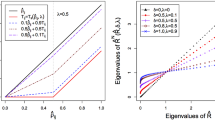Abstract
When shrinking a covariance matrix towards (a multiple) of the identity matrix, the trace of the covariance matrix arises naturally as the optimal scaling factor for the identity target. The trace also appears in other context, for example when measuring the size of a matrix or the amount of uncertainty. Of particular interest is the case when the dimension of the covariance matrix is large. Then the problem arises that the sample covariance matrix is singular if the dimension is larger than the sample size. Another issue is that usually the estimation has to based on correlated time series data. We study the estimation of the trace functional allowing for a high-dimensional time series model, where the dimension is allowed to grow with the sample size—without any constraint. Based on a recent result, we investigate a confidence interval for the trace, which also allows us to propose lower and upper bounds for the shrinkage covariance estimator as well as bounds for the variance of projections. In addition, we provide a novel result dealing with shrinkage towards a diagonal target. We investigate the accuracy of the confidence interval by a simulation study, which indicates good performance, and analyze three stock market data sets to illustrate the proposed bounds, where the dimension (number of stocks) ranges between 32 and 475. Especially, we apply the results to portfolio optimization and determine bounds for the risk associated to the variance-minimizing portfolio.






Similar content being viewed by others
References
Andrews DWK (1991) Heteroscedasticity and autocorrelation consistent covariance matrix estimation. Econometrica 69(3):817–858
Bai Z, Silverstein JW (2010) Spectral analysis of large dimensional random matrices, 2nd edn. Springer, New York
Berkes I, Horváth L, Kokoszka P, Shao Q (2005) Almost sure convergence of the Bartlett estimator. Period Math Hung 51(1):11–25
Bollerslev T (1986) Generalized autoregressive conditional heteroskedasticity. J Econom 31:307–327
Brockwell PJ, Davis RA (2006) Time series: theory and methods. Springer series in statistics. Springer, New York
Brodie J, Daubechies I, De Mol C, Giannone D, Lorris I (2009) Sparse and stable Markowitz portfolios. Proc Natl Acad Sci USA 106:12267–12272
Cover TM (1991) Universal portfolios. Math Finance 1:1–29
Engle RF, Kroner KF (1995) Multivariate simultaneous generalized ARCH. Econom Theory 11(1):122–150
Francq C, Zakoian JM (2010) GARCH models: structure, statistical inference and financial applications. Wiley, Chichester
Györfi L, Lugosi G, Udina F (2006) Nonparametric kernel-based sequential investment strategies. Math Finance 16(2):337–357
Hsiao PY, Cheng HC, Huang SS, Fu LC (2009) CMOS image sensor with a built-in lane detector. Sensors 9:1722–1737
Kouritzin MA (1995) Strong approximation for cross-covariances of linear variables with long-range dependence. Stoch Process Appl 60(2):343–353
Ledoit O, Wolf M (2003) Improved estimation of the covariance matrix of stock returns with an application to portfolio selection. J Empir Finance 10:603–621
Ledoit O, Wolf M (2004) A well-conditioned estimator for large-dimensional covariance matrices. J Multivar Anal 88:365–411
Newey W, West KD (1987) A simple, positive semi-definite, heteroskedasticity and autocorrelation consistent covariance matrix. Econometrica 55(3):703–708
Philipp W (1986) A note on the almost sure approximation of weakly dependent random variables. Monatshefte Mathematik 102(3):227–236
Sancetta A (2008) Sample covariance shrinkage for high dimensional dependent data. J Multivar Anal 99(5):949–967
Steland A (2012) Financial statistics and mathematical finance: methods, models and applications. Wiley, Chichester
Steland A, von Sachs R (2017a) Large sample approximations for variance-covariance matrices of high-dimensional time series. Bernoulli 23(4A):2299–2329
Steland A, von Sachs R (2017b) Asymptotics for high-dimensional covariance matrices and quadratic forms with applications to the trace functional and shrinkage. Stoch Process Appl (to appear). arXiv:1711.01835
Wang WZ, Guo YW, Huang BY, Zhao GR, Liu BQ, Wang L (2011) Analysis of filtering methods for 3D acceleration signals in body sensor network. In: International symposium on bioelectronics and bioinformations, Shuzu
Acknowledgements
This work was supported by a grant from Deutsche Forschungsgemeinschaft, grant STE 1034/11-1. Comments from anonymous reviewers are appreciated.
Author information
Authors and Affiliations
Corresponding author
Appendix A: Proof of Theorem 4.2
Appendix A: Proof of Theorem 4.2
We give a sketch of the proof. We apply Steland and von Sachs (2017b, Theorem 2.3), which generalizes Steland and von Sachs (2017a) and is based on techniques of Kouritzin (1995) and Philipp (1986). Steland and von Sachs (2017b, Theorem 2.3) is applied with \( \varvec{v}_n^{(j)} = \varvec{w}_n^{(j)} = \varvec{e}_j \), where \( \varvec{e}_j \) denotes the jth unit vector of the Euclidean space \( \mathbb {R}^{d_n} \), \( j = 1, \dots , d_n \) and \( L_n = d_n \). Basically, the result asserts that, on a new probability space, one can approximate the partial sums
by a Brownian motion, and here the number of such bilinear forms \( L_n \) (\(= d_n\) in our case) given by \(L_n \) pairs of weighting vectors, may grow to \( \infty \). Using the notation and definitions of Sect. 2.3 of Steland and von Sachs (2017b), we obtain
By Steland and von Sachs (2017b, Theorem 2.3) we may redefine the above processes, on a new probability space together with a Gaussian random vector \( \varvec{B}_n = (B_{n1}, \dots , B_{nd_n} )' \) with \( {{\mathrm{\mathbb {E}}}}( \varvec{B}_n ) = 0 \) and covariances given by
where \( \widetilde{\beta }_n^2( \nu , \mu ) \) satisfy
by Lemma 2.1 and Theorem 2.2 of Steland and von Sachs (2017b) (there the quantities \( \widetilde{\beta }_n^2( \nu , \mu ) \) are denoted by \( \beta _n^2( \nu , \mu )\)), such that the strong approximation
as \(n \rightarrow \infty \), a.s., holds true. But this immediately yields
as \( n \rightarrow \infty \), a.s. Now both assertions follow, because
\(\square \)
Rights and permissions
About this article
Cite this article
Steland, A. Shrinkage for covariance estimation: asymptotics, confidence intervals, bounds and applications in sensor monitoring and finance. Stat Papers 59, 1441–1462 (2018). https://doi.org/10.1007/s00362-018-1040-y
Received:
Revised:
Published:
Issue Date:
DOI: https://doi.org/10.1007/s00362-018-1040-y




